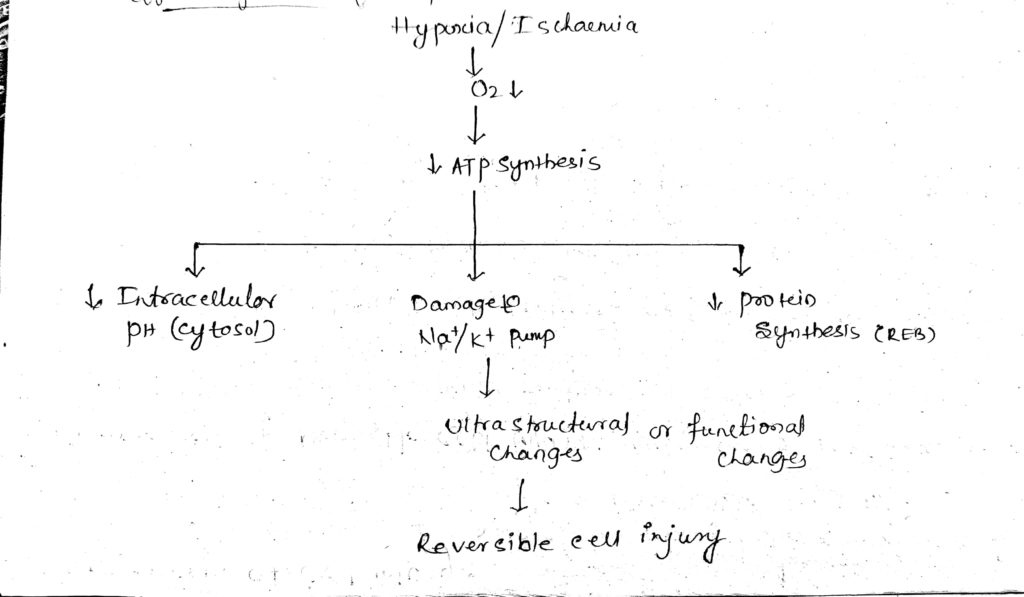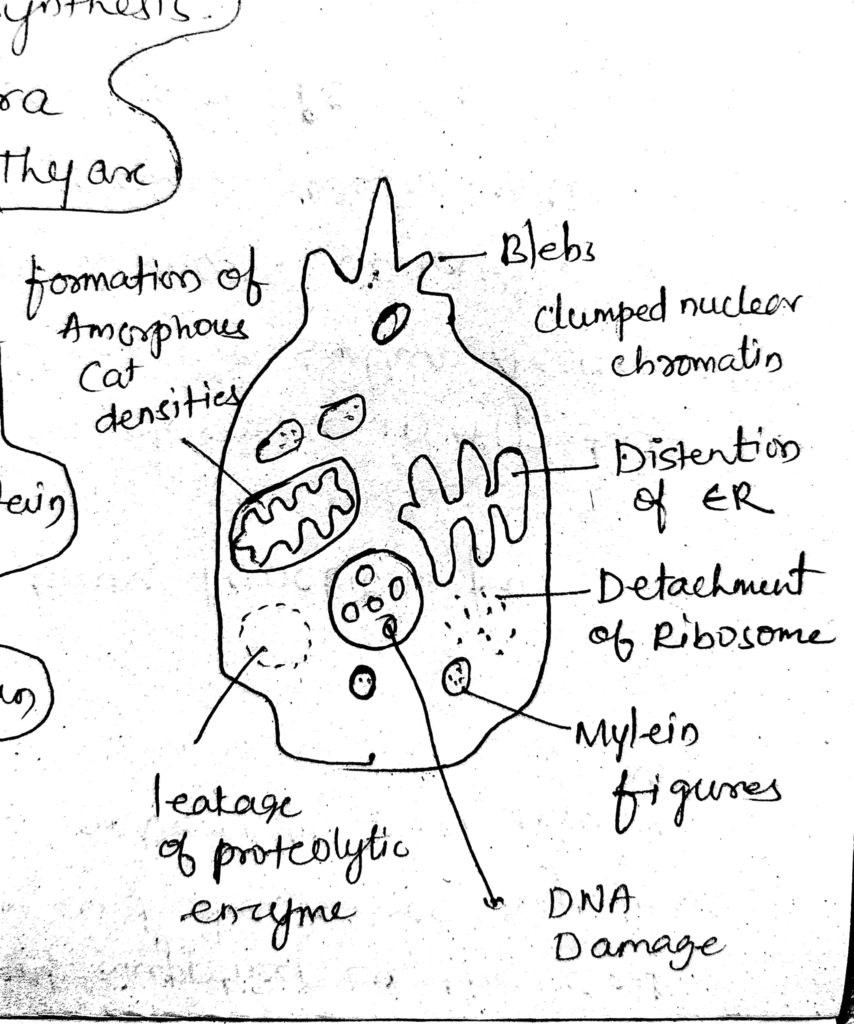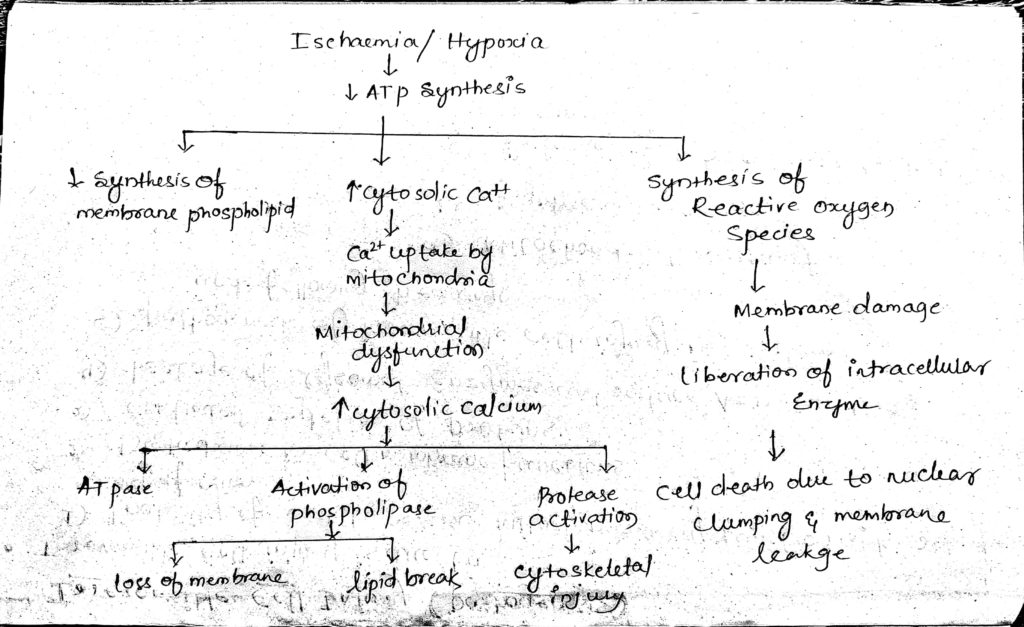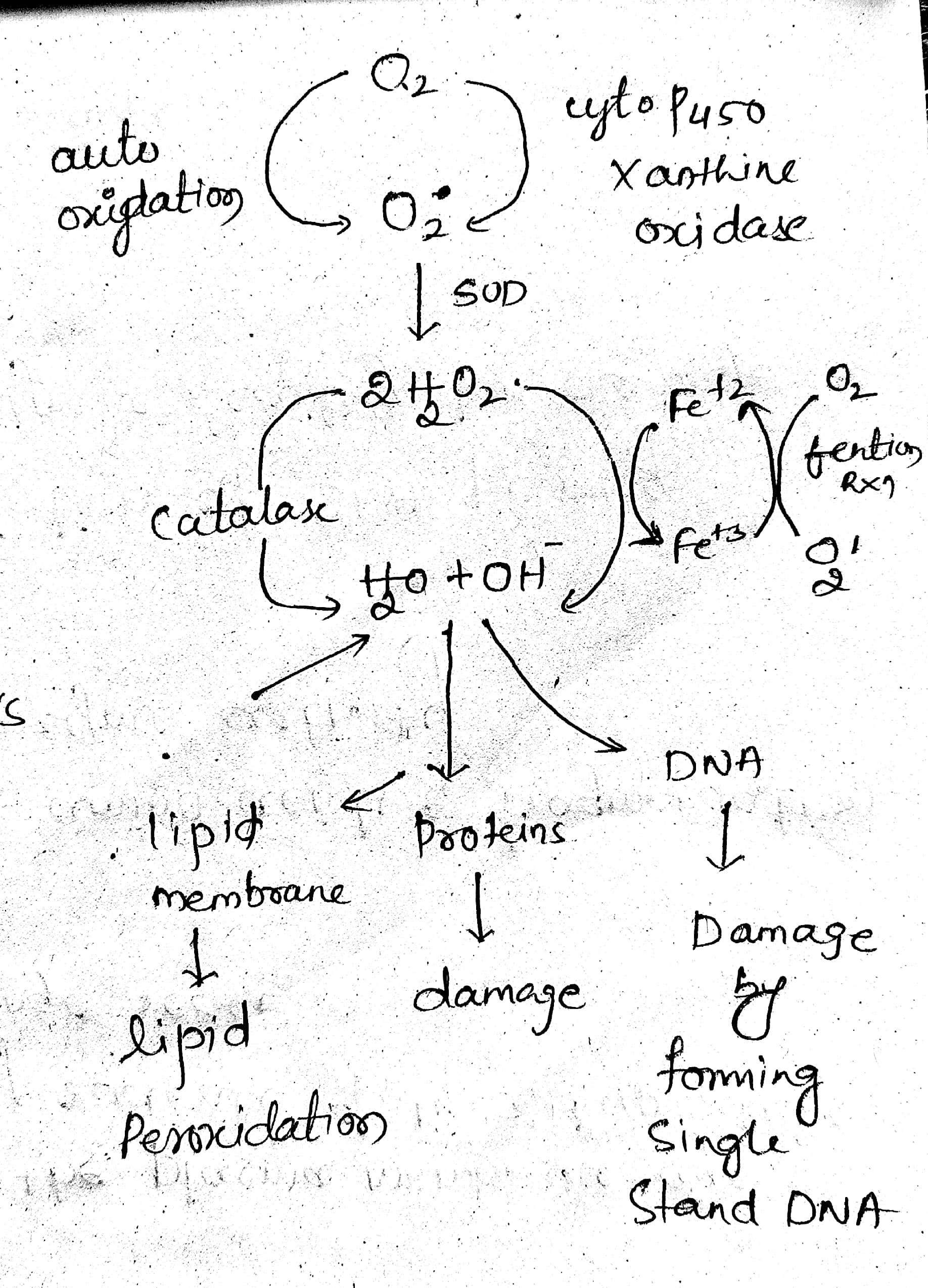pathogenesis of cell injury: injury to the normal cell by one or more of the etiology agent (immunological agent, psychological agent, chemical agent, physical agent & microbial agent) may result in a state of reversible or irreversible cell injury.
- Mechanism of reversible cell injury: principle:
- Pathogenesis depends on type, duration and severity of injuries agent.
- types status and adaptivity of cell towards cell injury.
- Underlining intracellular phenomena.
- ATP is a form of energy required for cell to carry out various process like
- Membrane transport
- Production of protein, lipids
- Metabolism.
- ATP is produced either by oxidative phosphorylation ie. Aerobic respiration or anaerobic respiration.
- In Ischaemic there is a oxygen and glucose which inturn effect synthesis of ATPs.

hypoxia and ischemia reduce oxygen content supplied to the cell symptoms effect oxidative phosphorylation and decreased synthesis of decrease ATP level can cause reversible cell injury in following ways.
- Damage to sodium potassium pump: sodium potassium(Na+/K+)pump present at the plasma membrane function for restoration of cell negative character. If sodium after action potential due to decrease in ATP this pump cannot function which cause excessive sodium accumulation intracellularly due to excessive sodium osmosis condition are disturbed and to maintain isosmotic nature water enter inside the cell and cell organelles leading to hydropic swelling.
- Reduced intracellular pH: due to lack of oxidative phosphorylation self shift itself from Aerobic to anaerobic respiration causing glycolysis and product is lactic acid which accumulates in cell reducing intracellular pH. Increase acidity can damage a cell by protein co- agulation.
- Decrease Protein synthesis: due to reduced ATP and failure of sodium potassium pump hydropic swelling of cell and organelles is seen distension of endoplasmic reticulum leads to to the attachment of ribosome and formation of monosomes further decrease Protein synthesis.
- All the above mention factor leads to ultra structural and functional changes of cell. They are
- Destination of endoplasmic reticulum
- Mitochondrial swelling and formation of calcium amorphous density
- Formation of myelin figures which contain phospholipids molecule
- Clumping of nuclear chromatin it can cause loss of genetic material.

- Mechanism of irreversible cell injury: Irreversible cell injury due to
- Inability of cell to reverse mitochondria dysfunction after reperfusion.
- Disturbance in cell membrane function
- Continued depletion of protein.
- Leakage of lysosomal enzyme and reduce ATP synthesis.
- Pathogenesis of irreversible cell injury is explain under following headings.
- Mitochondrial dysfunction
- Membrane damage
- Release of intracellular hydrolytic enzyme.

- mitochondrial dysfunction: persistent hypoxia and ischemia increase cellular calcium level, which is up taken by mitochondria.After reperfusion excessive calcium enters inside the cell which further damaged mitochondria by forming amorphous calcium densities. Vacumes and increases mitochondrial permeability concentration of calcium in blood is higher compared to intracellular calcium level after reperfusion calcium concentration intracellularly increase which can not be maintained by cell. Due to increased mitochondrial permeability calcium present inside the mitochondria and endoplasmic reticulum enters again into the cytoplasm, cytochromic is liberated intracellularly which can induce apoptosis.
- Membrane damage: membrane damage occurs due to following mechanism
- Accerlated degradation of membrane of phospholipid: increase in cytosolic calcium activates phospholipids which acts on membrane phospholipase causing membrane damage due to degradation of phospholipids.
- Cytoskeletal damage: intermediate filaments which are present very site of membrane maintain integrety cell membrane activation of protease and hydropic swelling cause degradation of these filaments leading to membrane damage.
- Lipids breakdown product: These kind of product combines with intracellular ions and forms soap which damage cell membrane.
- Toxic oxygen radicals: Toxic oxygen radicals like superoxide anion O2-, H2O2, peroxy nitrate, OHONO etc are synthesized during oxidation which can act an lipids DNA and protein causing these degradation.
- Hydrolytic enzyme: increase in calcium level leads to activation of phospholipase and activation of protease causing membrane damage of lysosomal membrane and can lead to release of enzyme by RNAase, DNAase, protease, Glycocytases,Catlepsin etc. Which carry about protein damage to RNA and DNA causing pyknosis, karyohexis and karrylysia of DNA. Damage phospholipid meleculus combine with calcium and are present inside the cell as myelin figures.

- Synthesis of Hydroxyl Radicals:
- Lipid peroxidation: polyunsaturated fatty acids present in the plasma membrane and forms lipid hydroperoxy radicals and lipid hypopoxides which further initiates catalytic change reaction.
- Protein Damage: Sulphaydryl mediates cross linking of amino acids and fragmentation of polypeptide leads to loss of enzyme activity.
- DNA Damage: These oxygen radical cause fragmentation of DNA forming single standard DNA mainly at thymine leading to damage of nuclear and mitochondrial DNA.
